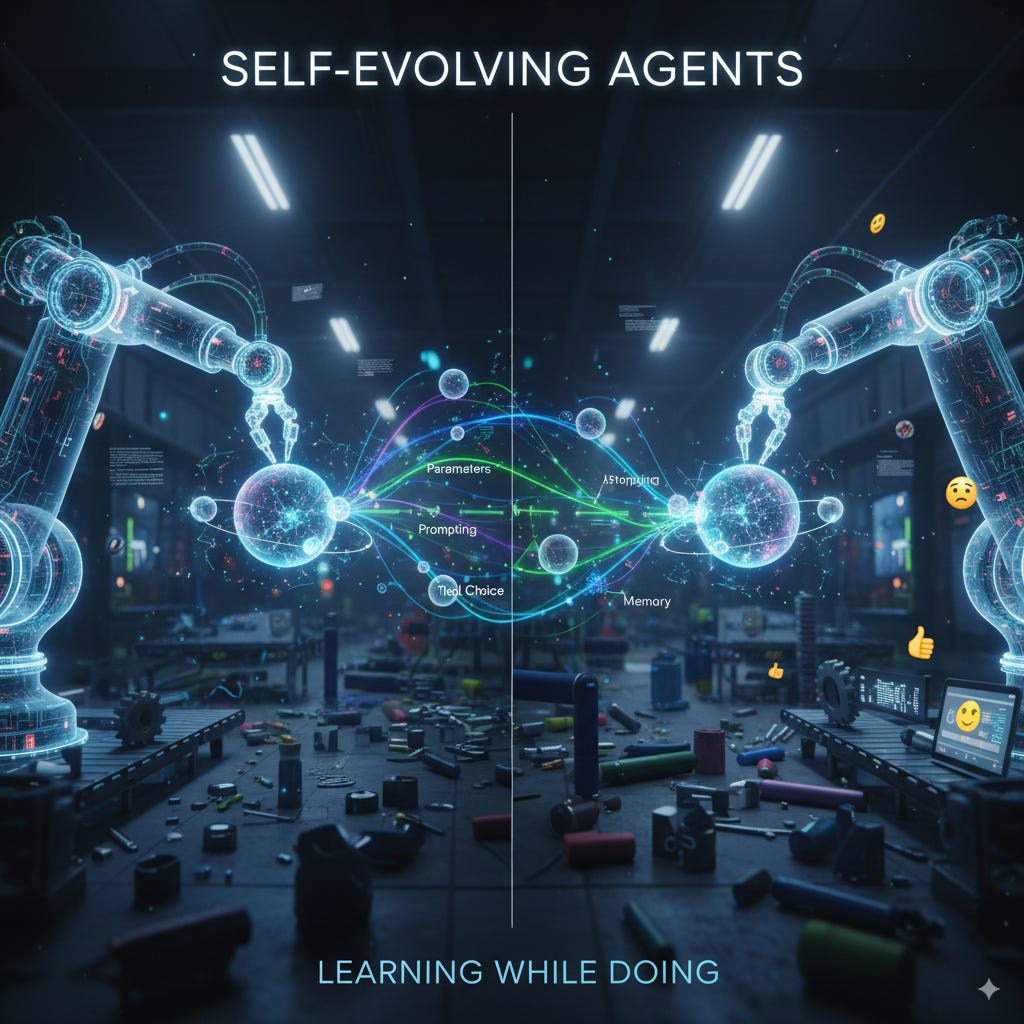Self-Evolving Agents
The Next Frontier in Agentic AI
“Most agent systems today are built, configured, and then deployed; but what if they could evolve themselves, continually adapting to changing environments and feedback?”
Recent research is pointing in that direction. A new survey paper, A Comprehensive Survey of Self-Evolving AI Agents [1], defines this paradigm as the bridge between static foundation models + manually configured agents, and lifelong, adaptive agentic systems.
Here’s a breakdown of what “self-evolving” means, why people are excited, what challenges are being surfaced, and what to keep an eye on.
What are Self-Evolving Agents
Self-evolving agents are AI agents that:
Collect feedback from their environment (user interaction, failures, changing goals).
Use that feedback to automatically refine some aspect of their behaviour (e.g. parameters, prompting, tool choice, memory).
Adapt over time to new conditions without full manual re-deployment.
Potentially improve autonomously in task decomposition, tool usage, error correction, or choosing when to escalate / ask for help.
This isn’t simply retraining offline or fine-tuning every few months; it’s about putting in place feedback loops, monitoring, optimisers, evaluators, etc., so the agent “learns while doing.”
Why It’s Gaining Traction
A few drivers are making self-evolving agents more than a research curiosity:
Dynamic Environments: Tasks, data distribution, and user expectations change. Agents that are static tend to degrade in performance or require overhead to maintain.
Scalability Requirements: As more agents are deployed (in enterprises, products, ops), manually updating each one becomes expensive and brittle. Self-evolution can help scale upkeep.
Better Performance Margins: Early experiments show that agents with access to feedback/sharing evaluation data outperform those without it, leading to better adaptability and fewer failures. The survey finds that labs using shared feedback (“AgentRxiv” style) show measurable improvements.
Pressure on Continuous Improvement: With rapid iteration cycles in products, being able to adapt agents post-deployment is a big competitive advantage.
Technical Challenges and Limitations
But it’s not all smooth. Self-evolution introduces nontrivial risks and engineering challenges:
Feedback & Signals Noise: Getting the right feedback is hard. If the agent misinterprets signals (user behaviour, success/failure), changes may degrade performance.
Stability vs Plasticity Tradeoffs: Agents that adapt too aggressively may “forget” prior knowledge or wander off into undesirable behaviours.
Safety, Trust, Governance: Automatic adaptation risks drift, unintended behaviours, bias creep, etc. How to audit evolving agents? How to ensure they remain aligned over time?
Compute & Resource Overheads: Continuous monitoring, retraining, evaluation, and updating incurs cost. Might require infrastructure and tooling that many organizations don’t yet have.
Evaluation Challenges: How do you measure improvement reliably over time? Benchmarks may not reflect real-world complexity; measuring generalization, fairness, robustness gets trickier as agents evolve.
Where We’re Seeing Progress / Use Cases
Some areas where self-evolving agents are starting to show promise:
Academic prototypes: As noted, frameworks like AgentRxiv show how agents sharing prior research and community feedback can boost results.
Domain-specific evolution: In fields with stable evaluation metrics (e.g. programming / code generation, finance, biomedical tasks), evolving agents using feedback loops is more manageable.
Enterprise internal tools: Some companies are experimenting with agents that monitor their own failure modes, collect data on mis-steps, then suggest or even apply fixes under oversight.
What to Watch & Strategic Implications
For anyone designing, deploying, or scaling agentic AI, self-evolving agents raise both opportunities and strategic imperatives.
Tooling & Infrastructure Needs: To support self-evolution, you’ll need systems for logging, feedback collection, versioning, rollbacks, safety checks, evaluation pipelines, etc.
Governance by Design: Build in guardrails from the outset – permissions, oversight layers, human-in-the-loop checkpoints, drift detection.
Human + Agent Collaboration: Even the best-evolving agent will need humans to set goals, define what success looks like, interpret unexpected behaviour, intervene.
Incremental Deployment: Probably safer to start with self-evolution in low-risk components or sandboxed agents before moving to mission-critical ones.
Measuring What Matters: Not just accuracy or speed, but robustness, alignment, fairness, maintainability over time.
Bottom Line
Self-evolving agents are one of the most interesting emerging themes in agentic AI. They promise adaptability and scaling power, potentially pushing agents from being periodically updated tools to living, evolving collaborators. But realizing that promise demands new kinds of infrastructure, rigorous attention to trust and safety, and careful design of feedback loops.
As you think about your roadmap, self-evolution might not be for every use case yet; but it’s increasingly becoming a must-consider. For anyone building or managing agents, you’ll want to decide:
Where in your stack self-evolution makes sense first (which agents or sub-components).
How to instrument feedback and monitoring well.
What governance model you will use to keep evolving agents from going off course.


